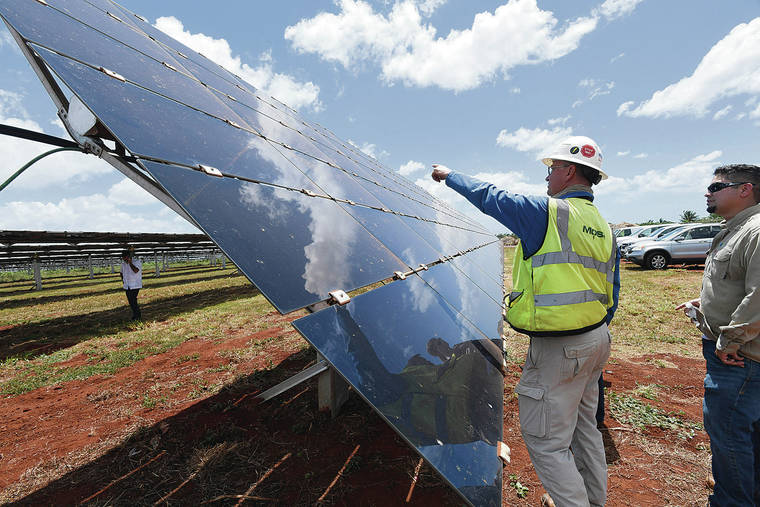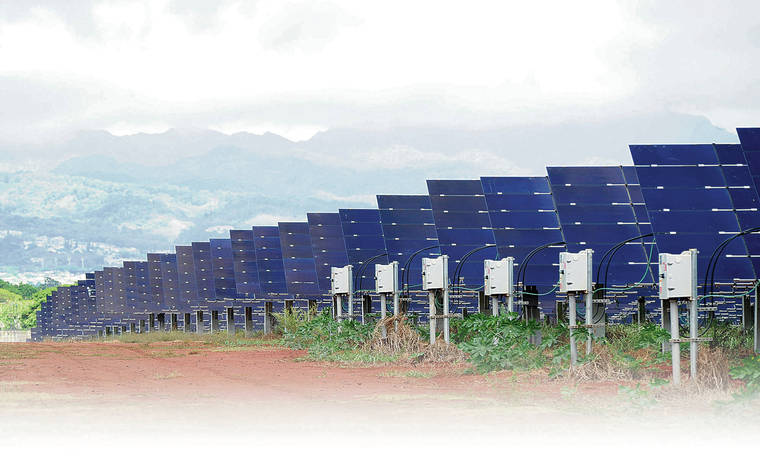State’s largest solar block goes online


BRUCE ASATO / BASATO@STARADVERTISER.COM
Kurtis Bell, superintendent for Moss & Associates, general contractor, at one of the solar panel arrays at the Mililani Solar II facility, answered questions from an event guest.

BRUCE ASATO / BASATO@STARADVERTISER.COM
Rows of solar panels are lined up at the Mililani Solar II facility. Over 150,000 solar panels produce 14.7 megawatts of power.

BRUCE ASATO / BASATO@STARADVERTISER.COM
Kahu Kordell Kekoa, right, officiated in the Hawaiian blessing Tuesday with principals preparing for the untying of the maile lei: Connie Lau, HEI president and CEO; Craig Cornelius, chief executive officer of Clearway Energy Group; Alan Oshima, president/CEO at Hawaiian Electric Co.; and Gov. David Ige.

BRUCE ASATO / BASATO@STARADVERTISER.COM
Guests at Tuesday’s blessing ceremony walked with a backdrop of solar panels and the Waianae Mountains, above.





The sun was shining brightly in Mililani on Tuesday as officials welcomed the the state’s largest collection of solar farms, a trio of sun-powered projects that will generate enough electricity to light up nearly 18,000 homes.
“This project today means thousands and thousands, probably millions, of gallons of fossil fuels over the life of the panels will not be needed,” Gov. David Ige said. “It is a glimpse into the future.”
The governor joined officials with Hawaiian Electric Co. and developer Clearway Energy Group for a Hawaiian blessing amid rows and rows of solar panels at Mililani Solar II project.
Commercial operations at the three projects at Kawailoa, Waipio and Mililani were launched Tuesday following the blessing.
Together, the projects are home to more than 833,000 solar panels generating 110 megawatts of power, estimated to make up for the belching of 1.2 million tons of greenhouse gas emissions over 20 years.
The projects represent the largest block of grid‐scale solar power ever developed in Hawaii, officials said, and will be responsible for 3% to 4% of Hawaii’s renewable energy goal, which reached 27% at the end of 2018.
Don't miss out on what's happening!
Stay in touch with breaking news, as it happens, conveniently in your email inbox. It's FREE!
There was a time a few years ago when this project appeared it would never see the light of day. The original developer, SunEdison, was failing financially and missing contract deadlines, and Hawaiian Electric was forced to terminate its agreement in February 2016.
“We had to pull the plug on SunEdison before it went into bankruptcy to try to preserve Hawaii jurisdiction,” said Alan Oshima, president and CEO of Hawaiian Electric.
Hawaiian Electric took some heat for the move, but the bankruptcy court was in New York, Oshima said, and there was a good chance the project would have died there.
“I’m just happy it worked out the way we thought it would,” he said.
The projects were acquired by Clearway’s predecessor at the end of November 2016.
“On the very morning that the sale of this portfolio closed under the bankruptcy court’s auspices, we walked into Alan Oshima’s office and talked with him about fixing these back up,” said Craig Cornelius, CEO of San Francisco-based Clearway.
Clearway and Hawaiian Electric ultimately renegotiated lower prices for the three projects.
“Things happened extraordinarily fast because (Hawaiian Electric) wanted to get it built and do right by the ratepayers of this state,” Cornelius said.
Ige said he was eager to welcome the projects as the state has committed to 100% renewable energy, has aligned its clean-energy goals with the Paris Climate Accord and is committed to achieving a carbon-neutral economy by 2045.
“We need to achieve these bold agenda items one step at a time, and certainly this collection of projects is a giant leap forward,” Ige said.
Regarding the 4% dent in the state’s renewable energy commitment, Cornelius said, “It sounds like a small number, but you do this 25 more times and you’re done. In fact, you need to do it less than that with 30% already in the system.”
The three projects are:
>> The 49-megawatt Kawailoa Solar, which sports nearly a half-million solar panels and is the largest solar project in the state. The projected sits on former sugar cane land owned by Kamehameha Schools and is next to the state’s largest wind farm on the North Shore of Oahu. The solar project shares existing roads, substation and transmission lines with the wind project. Clearway is working with local ranchers to allow them the grazing of sheep for vegetation management.
>> The 45.9-megawatt Waipi‘o Solar project has more than 160,000 panels on former cattle pasture now owned by Clearway. Sheep grazing is also expected to help with vegetation management.
>> The 14.7-megawatt Mililani Solar II project consists of over 150,000 solar panels and is constructed on former pineapple land owned by Clearway. The project operates alongside active farming operations in the Mililani Agricultural Park.
In April the state Public Utilities Commission approved two additional projects: Mililani Solar I and Waiawa Solar Power, totaling 75 megawatts of solar and 300 megawatt hours of battery storage. The projects are expected to go online at the end of 2021.



